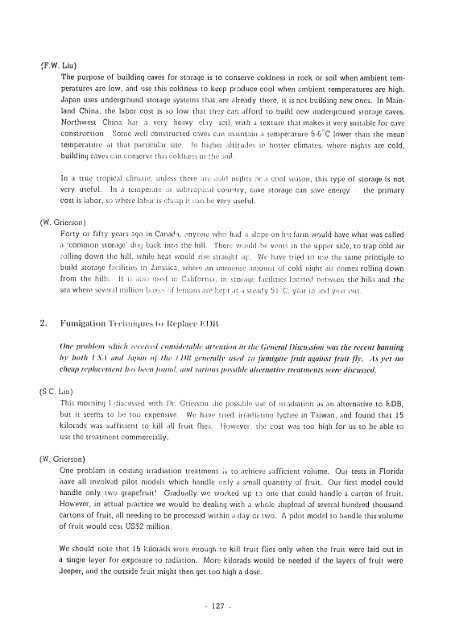7 - part
7 - part
7 - part
Create successful ePaper yourself
Turn your PDF publications into a flip-book with our unique Google optimized e-Paper software.
(F.W. Liu)<br />
The purpose of building caves for storage is to conserve coldness in rock or soil when ambient tem<br />
peratures are low, andi use this coldness to keep produce cool when ambient temperatures are high.<br />
Japan uses underground storage systems that are already there, it is not building new ones. In Mainland<br />
China, the labor cost is so low that they can afford to build new underground storage caves.<br />
Northwest China haF a very heavy clay soil, with a texture that makes it very suitable for cave<br />
construction Some well constructed caves can maintain a,temperature 5-6'C lower than the mean<br />
temperature at that <strong>part</strong>icular site. in higher altitudes in hotter climates, where nights are cold,<br />
building caves can conserve this coldile:S in the ';nil.<br />
In a true tropical clinia te, unless there ire "'old nights :)r a cool season, this type of storage is not<br />
very useful. In a temperate ')rsubtropical co.itry, cave storage can save energy the primary<br />
cost is labor, so vhere labor is cheap it can be very useful.<br />
(W. Grierson)<br />
Forty or fifty years ago in Canadwi, onyone who had a slope on his farm would have what was called<br />
a 'common storage' dug back into the hill. Then, would he vents in the upper side, to trap cold air<br />
rolling down the hill, while heat would rise straight tp. We hive tried to use the same principle to<br />
build storage facilities in Jamaica, where an immense iniount of cold night air comes rolling down<br />
from the hills. It k i:;, .ed ill California. in storage facilities locatedr etween the hills ard the<br />
sea where sevral million ,x -,f lemons are kept it i steady 51 C, year i:l-ind year out.<br />
2. Fumigation 'l'cl1ti(Ju(s Ii l0pItLUe I)K1l<br />
One problem which re'ccie, coulhid'rahh (falfionl in the General l)iseti.ision was the recel banning<br />
lit both IS.I and Jlapan 0 th, 1t1he ) ,i' nerall'r used ;r)jimflgne f'uil agailst ft'uit J'. As 'et tin<br />
cheap replaceineut le, beenjfnnld,(nd iriou possible alternalive treatments were discussed.<br />
(S C. Lin)<br />
This morning I discusseci with fDr. Griersoit die possihle use of irradiation as an alternative to EDB,<br />
but it seems to be too expensive. We have tried irradiatin'i lychee in Taiwan, and found that 15<br />
kilorads was sufficient to kill all fruit flies. lowever, the cost was too high for us to be able to<br />
use the treatment commercially.<br />
(W. Grierson)<br />
One problem in costing irradiation treatment i,to achieve sufficient volume. Our tests in Florida<br />
have all involved pilot models which handle only a small quantity of fruit. Our first model could<br />
handle only two grapefruit! Gradually we worked up t- one that could handle a carton of fruit.<br />
However, in actual practice we would be dealing with a whole shipload of several hundred thousand<br />
cartons of fruit, all needing to be processed within a (lay cr two. A pilot model to handle this volume<br />
of fruit would ccsi US$2 million.<br />
We should note that 15 kilorads were enough to kill fruit flies only when the fruit were laid out in<br />
a singie layer for exposure to radiation. More kilorads would be needed if the layers of fruit were<br />
deeper, and the outside fruit might then get too high a dose.<br />
- 127

















